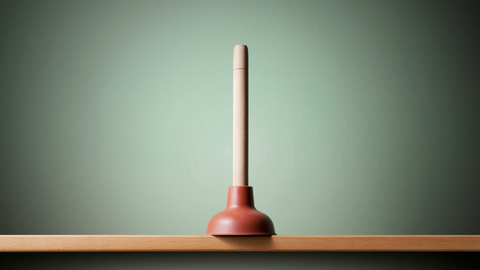
3 Mistakes You Must Stop Doing for Effective Plunging
Share
The toilet is one of the most important fixtures in your home, and keeping it clean is a top priority. But sometimes, your toilet can become clogged even with the best cleaning efforts. When this happens, you'll need to know how to plunge your toilet to clear the blockage effectively.
You'll need to do a few things to ensure your plunging efforts are successful. In this article, let's look at the mistakes you must avoid and ways to improve plunging.
Why Is Plunging Important?
Have you ever wondered why plunging is so essential? Well, there are a few reasons why this simple act can be so beneficial. For one, it can help to remove any potential blockages in your drains. This is especially important if you have a lot of hair in your drains, as it can quickly build up and cause a blockage.
Plunging can also help to break up any clumps of grease or soap that may have built up in your drains. This can be particularly helpful if your drains tend to get clogged easily. By breaking up these clumps, you can help to keep your drains flowing freely.
Finally, plunging can also help to remove any foul odors that may be coming from your drains. If your drains smell bad, it is likely because something caught in them is causing the odor. Plunging your drains can help remove the odor's source and keep your drains smelling fresh and clean. Another extra step that can be taken is to use a odor eliminator to reduce the stench.
What Plunging Mistakes Should You Avoid?
1. Skipping the Petroleum Jelly

If you're going to be plunging a toilet, you need to use a plunger with a good seal. Otherwise, all your effort will push the water around and not do anything to clear the clog. To get a good seal, you need to put some petroleum jelly on the edge of the plunger. This will help it create a suction that will be more effective at dislodging the clog.
2. Failing to Maintain the Seal
Once the plunger is in place, you need to keep a good seal. The best way to do this is to put your weight on the plunger and then push and pull it up and down in a steady rhythm. If you break the seal, you'll just be wasting your time.
3. Not Holding the Plunger at the Correct Angle
When you're using a plunger, you need to hold it perpendicular to the ground. Otherwise, you will need more suction to dislodge the clog. If you're having trouble getting a good seal, try holding the plunger at a different angle.
What Are the Best Practices for Effective Plunging?
The answer to this question may seem obvious, but there are actually a few different things you can do to ensure that your plunging is as effective as possible.
First and foremost, make sure that you have a good plunger. A plunger with a good seal will create a stronger suction and be more effective at dislodging whatever is causing the blockage.
Secondly, ensure enough water in the toilet bowl to cover the plunger. This will create a better seal and help flush away debris once the blockage has been cleared.
Finally, when ready to plunge, use steady and consistent pressure. Plunging too hard can make the blockage worse, so it is crucial to find a happy medium. If you keep these things in mind, you should be able to clear any blockage quickly and easily.
Final Thoughts
A plunger can be a very effective tool when used correctly. Be sure to choose the right size plunger for the job, and use it with steady, even pressure.
If you want to plunge a toilet, bathtub, bathroom, sink, or shower stall, you should check out TubShroom by The Shroom Company. TubShroom is a minimalist strainer that will help you say goodbye to clogs forever. Shop now to enjoy its benefits!
More Articles from The Shroom Company
How to Plunge a Toilet: 3 Different Methods You Can Try
Is It Safe to Flush Hair Down A Toilet? What to Know
Chronic Shower Drain Clog? It Might Be Due to These 4 Things
7 Potential Reasons Why Your Home's Toilet Clogs
Disclosure: Links in this article are affiliate links to Amazon products. As an Amazon Associate, we earn from qualifying purchases.






